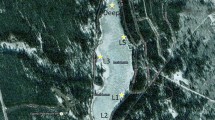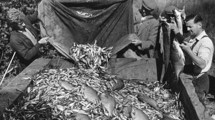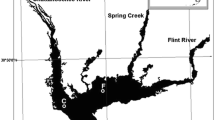Abstract
As expected from its short renewal time, the hypertrophic Lingese Reservoir responded rapidly but incompletely to external nutrient reduction in 1993. Although there was a sudden decline in lake phosphorus and chlorophyll concentrations, the ‘turbid regime’ revealed resistance in this weakly stratified reservoir of intermediate depth. Draining the reservoir in autumn 1995 provided an unprecedented opportunity for sediment treatment—the phosphorus-rich surface layer was inverted and covered with deeper nutrient-poor layers—and removal of the dense cyprinid fish stock which had not responded to sewage diversion, at least in the short term. Commencing with refilling in 1999, a new fish stock was built up from 2000 by only stocking predators (fingerlings of pike, pike-perch and larger specimens of rainbow-trout in the first years) in combination with catch restrictions. Concomitantly, with the appearance of daphnids in 1999, a ‘clear water regime’ was established and lake water phosphorus concentrations decreased at unchanged external loading. Reduced zooplanktivory as well as reduced fish-mediated phosphorus release from the sediments were driving mechanisms behind successful reduction of internal loading and achievement of a ‘clear water regime’. Hence, phosphorus concentrations were revealed to be a response variable not only to input management but also to food-web management. As the development of cyprinid dominance was prevented in the long-term, there is ample evidence that the fish community responded to the applied management measures as expected featuring successful food-web management. Overall, the biological structure was revealed to be of major importance for lake phosphorus availability and turbidity as in shallow lakes, without, however, the establishment of macrophyte dominance.





Similar content being viewed by others
References
Andersson, G., H. Berggren, G. Cronberg & C. Gelin, 1978. Effects of planktivorous and benthivorous fish on organisms and water chemistry in eutrophic lakes. Hydrobiologia 59: 9–15.
Andersson, G., W. Graneli & J. Stenson, 1988. The influence of animals on phosphorus cycling in lake ecosystems. Hydrobiologia 170: 267–284.
Appelberg, M., S. Ridderborg & U. Beier, 2000. Swedish standard methods for sampling freshwater fish with multi-mesh gillnets. Fiskeriverket Information 2000:1. National Board of Fisheries, Göteborg.
Benndorf, J., 1987. Food-web control without nutrient control: a useful strategy in lake restoration? Schweizerische Zeitschrift für Hydrologie 49: 237–248.
Benndorf, J., W. Böing, J. Koop & I. Neubauer, 2002. Top down control of phytoplankton: the role of time, scale, lake depth and trophic state. Freshwater Biology 47: 2282–2295.
Bergman, E., L. A. Hanson, A. Persson, J. A. Strand, P. Romane, M. Enell, W. Graneli, J. M. Svensson, S. F. Hamrin, G. Cronberg, G. Andersson & E. Bergstrand, 1999. Synthesis of theoretical and empirical experiences from nutrient and cyprinid reductions in Lake Ringsjön. Hydrobiologia 404: 145–156.
Bergstrand, E., 1990. Changes in the fish and zooplankton communities of Ringsjön, a Swedish lake undergoing man-made eutrophication. Hydrobiologia 191: 57–66.
Bloesch, J., 2004. Sedimentation and lake sediment formation. In O’Sullvian, P. E. & C. S. Reynolds (eds), The Lakes Handbook, Vol. 1. Blackwell-Science, Oxford: 197–222.
Botrell, H. H., A. Duncan, Z. M. Gliwicz, E. Grygierek, A. Herzig, A. Hilbricht-Ilkowska, H. Kursawa, P. Larsson & T. Wegelenska, 1976. A review of some problems in zooplankton production studies. Norwegian Journal of Zoology 24: 419–456.
Braband, A. & B. Faafeng, 1993. Habitat shift in roach induced by pikeperch introduction; predation risk versus pelagic behaviour. Oecologia 95: 38–46.
Braband, A., B. Faafeng & J. P. Nilsson, 1990. Relative importance of phosphorus supply to phytoplankton: fish excretion versus external loading. Canadian Journal of Fisheries and Aquatic Sciences 47: 364–372.
Carpenter, S. R., J. F. Kitchell & J. R. Hodgson, 1985. Cascading trophic interactions and lake productivity. Bioscience 35: 634–639.
Clasen, J., 1981. The reservoir project. Zeitschrift für Wasser- und Abwasserforschung 14: 80–87.
Cooke, G. D., E. B. Welch, S. A. Peterson & P. R. Newroth, 2005. Restoration and Management of Lakes and Reservoirs. Taylor & Francis, Boca Raton: 548 pp.
Deelder, C. L., 1951. A contribution to the knowledge of the stunted growth of perch in Holland. Hydrobiologia 3: 357–378.
Duncan, A., 1990. A review: limnological management and biomanipulation in the London reservoirs. Hydrobiolgia 200(201): 541–548.
Einsele, W., 1936. Über die Beziehungen des Eisenkreislaufs zum Phosphorkreislauf im eutrophen See. Archiv für Hydrobiologie 29: 664–686.
Elser, J. J., R. W. Sterner, A. E. Galford, T. H. Chrzanowski, D. L. Findlay, K. H. Mills, M. J. Paterson, M. P. Stainton & D. W. Schindler, 2000. Pelagic C:N:P stoichiometry in a eutrophied lake: response to a whole-lake food-web manipulation. Ecosystems 3: 293–307.
Gächter, R. & D. M. Imboden, 1985. Lake restoration. In Stumm, W. (ed.), Chemical Processes in Lakes. John Wiley & Sons, New York.
Gächter, R. & B. Müller, 2003. Why the phosphorus retention of lakes does not necessarily depend on the oxygen supply to the surface. Limnology and Oceanography 48: 929–933.
Genkai-Kato, M. & S. R. Carpenter, 2005. Eutrophication due to phosphorus recycling in relation to lakes morphometry, temperature and macrophytes. Ecology 86: 210–219.
Gesellschaft deutscher Chemiker, 2004. Deutsche Einheitsverfahren zur Wasser-, Abwasser- und Schlammuntersuchung. Wiley-VCH, Berlin.
Gliwicz, Z. M., 2004. Zooplankton. In O’Sullivan, P. E. & C. S. Reynolds (eds), The Lakes Handbook, Vol. 1. Blackwell, Oxford.
Güde, H., H. Rossknecht & G. Wagner, 1998. Anthropogenic impacts on the trophic state of Lake Constance during the 20th century. Archiv für Hydrobiologie/Advances in Limnology 53: 85–108.
Hanson, J. M. & W. C. Legett, 1982. Empirical prediction of fish biomass and yield. Canadian Journal of Fisheries and Aquatic Sciences 39: 257–263.
Henrikson, L., H. G. Nyman, H. G. Oscarson & J. A. Stenson, 1980. Trophic changes, without changes in the external nutrient loading. Hydrobiologia 68: 257–263.
Horppila, J. & T. Kairesalo, 1992. Impacts of bleak and roach on water quality, sedimentation and internal nutrient loading. Hydrobiologia 243(244): 323–331.
Hupfer, M. & J. Lewandowski, 2008. Oxygen controls the phosphorus release from lake sediments – a long-lasting paradigm in limnology. Internationale Revue der Hydrobiologie 93: 415–432.
Jeppesen, E., J. P. Jensen, P. Kristensen, M. Söndergaard, E. Mortensen, O. Sortkjär & K. Orlik, 1990. Fish manipulation as a restoration tool in shallow, eutrophic temperature lakes: the role of nutrient stage, submerged macrophytes and water depth. Hydrobiologia 342/343: 151–164.
Jeppesen, E., M. Söndergaard, J. P. Jensen & T. L. Lauridsen, 2003. Recovery from eutrophication. In Kumagai, M. & M. F. Vincent (eds), Freshwater Management: Global Versus Local Perspectives. Springer, Tokio.
Kahl, U. & R. J. Radke, 2006. Habitat and food resource use of perch and roach in a deep mesotrophic reservoir: enough space to avoid competition. Ecology of Freshwater Fish 15: 48–56.
Kubecka, J., 1993. Succession of fish communities in reservoirs of central and eastern Europe. In Straskraba, M., J. G. Tundidis & A. Duncan (eds), Comparative Reservoir Limnology and Water Quality Management. Kluwer Academic Publishers, Dordrecht: 153–168.
Lampert, W., 1987. Laboratory studies on zooplankton cyanobacteria interactions. New Zealand Journal of Marine Freshwater Research 21: 483–490.
Lyche, A., T. Andersen, K. Christoffersen, D. O. Hessen, P. H. Berger Hansen & A. Klysner, 1996. Mesocosm tracer studies. 1. Zooplankton as sources and sinks in the pelagic phosphorus cycle of a mesotrophic lake. Limnology and Oceanography 41: 460–474.
Manugistics, 1998. Statgraphics Plus. Manugistics, Rockville, USA.
Mazumder, A., D. J. McQueen, W. D. Taylor & D. R. S. Lean, 1988. Effects of fertilisation and planktivorous fish predation on size distribution of particulate phosphorus and phosphate: large enclosure experiments. Limnology and Oceanography 33: 421–430.
Mehner, T., M. Diekmann, U. Brämik & R. Lemke, 2005. Composition of the fish communities in German lakes related to lake morphology, trophic state, store structure and human-use intensity. Freshwater Biology 50: 70–85.
Mehner, T., M. Diekmann, T. Gonsiorczyk, P. Kasprzak, R. Koschel, L. Krienitz, M. Rumpf, M. Schulz & G. Wauer, 2008. Rapid recovery from eutrophication of a stratified lake by disruption of internal nutrient loading. Ecosystems 11: 1142–1156.
Ohle, W., 1955. Beiträge zur Produktionsbiologie der Gewässer. Archiv für Hydrobiologie, Supplement 22: 456–479.
Persson, L., 1987. Competition-induced switch in YOY perch, Perca fluviatilis: an experimental test of resource limitation. Environmental Biology of Fishes 19: 235–239.
Persson, A., 1997. Phosphorus release by fish in relation to external and internal load in a eutrophic lake. Limnology and Oceanography 42: 577–583.
Persson, L. & P. Eklöv, 1995. Prey refuges affecting interactions between piscivorous perch and juvenile prech and roach. Ecology 76: 70–81.
Persson, L., S. Diehl, L. Johanson, G. Andersson & S. F. Hamrin, 1991. Shifts in fish communites along the productivity gradient in temperate lakes – patterns and the importance of size-structured interactions. Journal of Fish Biology 38: 281–293.
Persson, L., A. M. DeRoos, D. Claessen, P. Byström, J. Lövgren, S. Sjögren, R. Svanbäck, E. Wahlström & E. Westman, 2003. Gigantic cannibals driving a whole-lake trophic cascade. Proceedings of the National Academy of Sciences USA 100: 4035–4039.
Persson, L., D. Claessen, A. M. DeRoos, P. Byström, S. Sjögren, R. Svanbäck, E. Wahlström & E. Westman, 2004. Cannibalism in a size-structured population: energy extraction and control. Ecological Monographs 74: 135–157.
Poister, D. & D. E. Armstrong, 2003. Seasonal sedimentation trends in a mesotrophic lake: influence of diatoms and implications for phosphorus dynamics. Biogeochemistry 65: 1–13.
Prairie, Y. T., C. de Montigny & P. A. DelGiorgio, 2001. Anaerobic phosphorus release from sediments: a paradigm revisited. Verhandlungen der Internationalen Vereinigung für Limnologie 27: 4013–4020.
Psenner, R., B. Boström, M. Dinka, K. Petterson, R. Pucsko & M. Sager, 1988. Fractionation of phosphorus in suspended matter and sediment. Archiv für Hydrobiologie, Beihefte Ergebnisse der Limnologie 30: 98–110.
Radke, R. J. & A. Gaupisch, 2005. Effects of phytoplankton-induced turbidity on predation success of piscivorous European perch: possible implications for fish community structure in lakes. Naturwissenschaften 92: 91–94.
Recknagel, F., M. Hosomi, T. Fukushima & D.-S. Kong, 1995. Short and long-term control of external and internal phosphorus loads in lake: a scenario analysis. Water Research 29: 1767–1779.
Rothaupt, K. O., 1992. Stimulation of phosphorus-limited phytoplankton by bacterivorous flagellates in laboratory experiments. Limnology and Oceanography 37: 750–759.
Salonen, K., R. I. Jones & L. Arvola, 2006. Hypolimnetic phosphorus retrieval by diel vertical migrations of Lake Phytoplankton. Freshwater Biology 14: 431–438.
Sas, H., 1989. Lake restoration by reduction of nutrient loading. Academia, St. Augustin: 497 pp.
Scharf, W., 1999. Restoration of the highly eutrophic Lingese Reservoir. Hydrobiologia 416: 85–96.
Scharf, W., 2007. Biomanipulation as a useful water quality management tool in deep stratifying reservoirs. Hydrobiologia 583: 21–42.
Scharf, W., 2008a. The use of nutrient reduction and food-web management to improve water quality in the deep stratifying Wupper Reservoir, Germany. Hyrobiologia 603: 105–115.
Scharf, W., 2008b. Development of the fish stock and its manageability in the deep, stratifying Wupper Reservoir. Limnologica 38: 248–257.
Scheffer, M., 2001. Alternative attractors of shallow lakes. The Scientific World 1: 254–263.
Schindler, D. W., 1977. Eutrophication and recovery in experimental lakes: implications for lake management. Science 184: 897–899.
Seda, J. & J. Kubecka, 1997. Long term biomanipulation of Rimov Reservoir. Hydrobiologia 345: 95–108.
Söndergaard, M., J. P. Jensen & E. Jeppesen, 2001. Retention and internal loading of phosphorus in shallow, eutrophic lakes. The Scientific World 1: 427–442.
Soranno, P. A., S. R. Carpenter & R. C. Lathrop, 1997. Internal phosphorus loading in Lake Mendota: response to external loads and weather. Canadian Journal of Fisheries and Aquatic Sciences 54: 1883–1893.
Tarvainen, M., J. Sarvala & H. Helminen, 2002. The role of phosphorus release by roach in the water quality changes of a biomanipulated lake. Freshwater Biology 47: 2325–2336.
Vollenweider, R. A., 1968. Scientific fundamentals of the eutrophication of lakes and flowing waters with particular reference to nitrogen and phosphorus as factors in eutrophication. DAS/CSI 68.27, OECD, Paris.
Vostradovsky, J., J. Krizek, O. Albertova, L. Ruzicka & M. Vostradovsky, 1989. The changes of fish communities and biomanipulation in water supply reservoirs. Archiv für Hydrobiologie, Beihefte Ergebnisse der Limnologie 33: 587–594.
Weisse, T., 2004. Pelagic microbes – protozoa and the microbial food web. In O’Sullivan, P. E. & C. S. Reynolds (eds), The Lakes Handbook, Vol. 1. Blackwell, Oxford.
Acknowledgement
Thanks to both referees for their helpful comments.
Author information
Authors and Affiliations
Corresponding author
Additional information
Handling editor: K. E. Havens
Rights and permissions
About this article
Cite this article
Scharf, W. Rehabilitation and management of a moderately deep-stratifying reservoir by the use of nutrient reduction and food-web management. Hydrobiologia 649, 77–94 (2010). https://doi.org/10.1007/s10750-010-0195-x
Received:
Revised:
Accepted:
Published:
Issue Date:
DOI: https://doi.org/10.1007/s10750-010-0195-x




